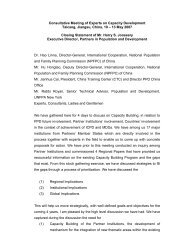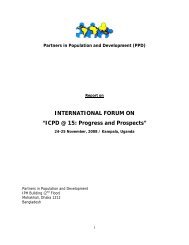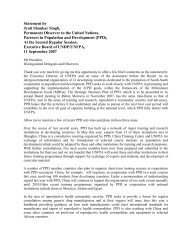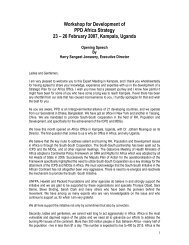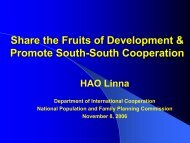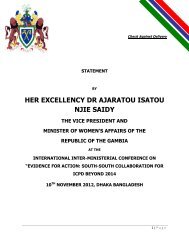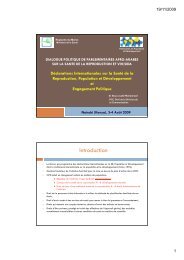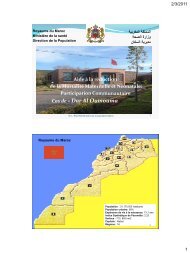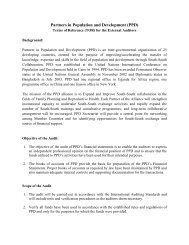Strategic Plan 2005-2014 - Partners in Population and Development
Strategic Plan 2005-2014 - Partners in Population and Development
Strategic Plan 2005-2014 - Partners in Population and Development
Create successful ePaper yourself
Turn your PDF publications into a flip-book with our unique Google optimized e-Paper software.
<strong>Partners</strong> <strong>in</strong> <strong>Population</strong> <strong>and</strong><strong>Development</strong>A South-South InitiativePermanent Observer at the United Nations<strong>Strategic</strong> <strong>Plan</strong><strong>2005</strong>-<strong>2014</strong>“The grow<strong>in</strong>g voice of the South”0
Table of ContentsA message from the Chairman................................................................................... 3Statement of the Executive Director ......................................................................... 41. Achievements of <strong>Partners</strong> <strong>in</strong> <strong>Population</strong> <strong>and</strong> <strong>Development</strong> ............................ 5-62.Values of <strong>Partners</strong> <strong>in</strong> <strong>Population</strong> <strong>and</strong> <strong>Development</strong> ......................................... 6-73.Global reproductive health, population <strong>and</strong> development context ................ 7-13a) Decl<strong>in</strong>e <strong>in</strong> <strong>in</strong>ternational commitment forreproductive health, population <strong>and</strong> development ...................................7-8b) Unmet reproductive health needs, <strong>in</strong>clud<strong>in</strong>g family plann<strong>in</strong>g, safemotherhood <strong>and</strong> adolescents reproductive health .................................. 8-9c) Global ris<strong>in</strong>g trends <strong>in</strong> the HIV/AIDS p<strong>and</strong>emic .................................. 9-10d) Infant <strong>and</strong> child health: an open wound <strong>in</strong> develop<strong>in</strong>g countries ............ 10e) Advances <strong>in</strong> universal access to education<strong>and</strong> <strong>in</strong> reduc<strong>in</strong>g gender imbalance ..............................................................10f) Advances <strong>in</strong> gender equity ......................................................................10-11g) Changes <strong>in</strong> global population structure ........................................ .........11-12h) Migration <strong>and</strong> displacement of populations .............................................. 12i) Lack of equitable distribution of the benefits of globalisation.............12-134. Challenges for <strong>Partners</strong> <strong>in</strong> <strong>Population</strong> <strong>and</strong> <strong>Development</strong> .....................13-145. Vision, Mission <strong>and</strong> <strong>Strategic</strong> Directions.................................................14-15Vision ............................................................................................................. 14Mission ............................................................................................................14<strong>Strategic</strong> Directions .......................................................................................156. <strong>Strategic</strong> Goals .......................................................................................... 15-171. ALIGN : The Alliance will align <strong>and</strong> be responsive to membercountries priorities <strong>in</strong> reproductive health <strong>and</strong> rights -<strong>in</strong>clud<strong>in</strong>gfamily plann<strong>in</strong>g <strong>and</strong> HIV/AIDS, population <strong>and</strong> development ................151
2. ADVOCATE : The Alliance will obta<strong>in</strong> support from differentstakeholders, both at national <strong>and</strong> at <strong>in</strong>ternational levels by advocat<strong>in</strong>gfor South-South collaboration ..................................................................... 163. ALLIANCES : The Alliance will form strategic alliances with selectedstakeholders to strengthen partnerships <strong>in</strong> meet<strong>in</strong>g the ICPD/PoA <strong>and</strong> theMDGs <strong>in</strong> the member countries ...................................................................164. ASSESTS : The Alliance will <strong>in</strong>crease its f<strong>in</strong>ancial base assets forsupport<strong>in</strong>g South-South collaboration activities on a susta<strong>in</strong>able basis,diversify<strong>in</strong>g the sources of fund<strong>in</strong>g <strong>and</strong> rais<strong>in</strong>g its Endowment Fund.....................................................................................................................16-177. <strong>Strategic</strong> Interventions ..............................................................................17-19a) Leadership development ...............................................................................17b) Policy <strong>and</strong> Programme development ...........................................................17c) Drugs <strong>and</strong> commodities exchange ..........................................................17-18d) Strengthen<strong>in</strong>g, <strong>in</strong>stitutionalis<strong>in</strong>g <strong>and</strong> dissem<strong>in</strong>at<strong>in</strong>g South-Southcollaboration ..................................................................................................18e) Improvement of <strong>in</strong>formation systems for decision mak<strong>in</strong>g .......................19f) Diversification of fund<strong>in</strong>g sources <strong>and</strong> modalities ......................................198. Milestones of achievements .......................................................................19-212
A message from the Chairman<strong>Partners</strong> <strong>in</strong> <strong>Population</strong> <strong>and</strong> <strong>Development</strong> is a vibrant alliance of develop<strong>in</strong>g countries thathas helped us achieve substantial success <strong>in</strong> sexual <strong>and</strong> reproductive health <strong>and</strong> rights,<strong>in</strong>clud<strong>in</strong>g family plann<strong>in</strong>g <strong>and</strong> HIV/AIDS, population <strong>and</strong> development dur<strong>in</strong>g the last tenyears. The Alliance is prepar<strong>in</strong>g itself to address the challenges created by the <strong>in</strong>creas<strong>in</strong>glycomplex globalisation scenario.<strong>Partners</strong> <strong>in</strong> <strong>Population</strong> <strong>and</strong> <strong>Development</strong>, has successfully transformed the South-Southcollaboration theory <strong>in</strong>to practice with<strong>in</strong> a very short period of time. There is no deny<strong>in</strong>g ofthe fact that today South-South collaboration has been embraced by many develop<strong>in</strong>gcountries as an essential way of development <strong>in</strong> the field of reproductive health, <strong>in</strong>clud<strong>in</strong>gfamily plann<strong>in</strong>g <strong>and</strong> HIV/AIDS. The current global situation calls for an <strong>in</strong>tense exchange ofpolicies, programmes, experience <strong>and</strong> expertise. The voice of more than half of the worldpopulation must cont<strong>in</strong>ue to be heard when decid<strong>in</strong>g the agenda on sexual <strong>and</strong> reproductivehealth <strong>and</strong> rights, <strong>in</strong>clud<strong>in</strong>g family plann<strong>in</strong>g <strong>and</strong> HIV/AIDS, population <strong>and</strong> development..Member countries of the Alliance have a multitude of urgent needs to be addressed whilefund<strong>in</strong>g <strong>and</strong> assistance is decreas<strong>in</strong>g drastically. We need to <strong>in</strong>crease the collaborationamong us, mak<strong>in</strong>g the South-South approach the preferred option for assistance. South-Southcollaboration will be <strong>in</strong>stitutionalised <strong>in</strong> member countries <strong>and</strong> additional funds will bemobilised through multiple channels, from member countries’ governments <strong>and</strong> theircorrespond<strong>in</strong>g private sector. <strong>Strategic</strong> partnerships will be established for this purpose.Innovative partnership arrangements among member countries to address specific countryneeds will create opportunities for exchange of policies, programmes, methods <strong>and</strong>commodities. Internal organisational arrangements will be boosted, specially the mechanismsto monitor performance. Ultimately, all levels of the Alliance, from the Board to theSecretariat, will be fully accountable to our governments <strong>and</strong> people.Board members will have an active <strong>and</strong> cont<strong>in</strong>uous role, represent<strong>in</strong>g the Alliance <strong>in</strong><strong>in</strong>ternational forums, <strong>in</strong> order to ensure a fair partnership with developed countries. Withequal voices develop<strong>in</strong>g <strong>and</strong> developed countries <strong>and</strong> developed nations can, <strong>and</strong> will buildsusta<strong>in</strong>ed <strong>and</strong> balanced human development help<strong>in</strong>g to eradicate poverty <strong>and</strong> discrim<strong>in</strong>ation.Let us start the second decade of this unique Alliance with a sense of optimism <strong>and</strong>renewed commitment towards South-South collaboration. Our union is our ma<strong>in</strong> strength.Our motto is the grow<strong>in</strong>g voice of our people dem<strong>and</strong><strong>in</strong>g a new <strong>in</strong>ternational order based onpeace, justice <strong>and</strong> mutual respect.Zhang Weiq<strong>in</strong>gChair of the <strong>Partners</strong> BoardM<strong>in</strong>ister of National <strong>Population</strong> <strong>and</strong>Family <strong>Plan</strong>n<strong>in</strong>g Commission, Ch<strong>in</strong>a3
Statement of the Executive DirectorFounded <strong>in</strong> 1994, <strong>Partners</strong> <strong>in</strong> <strong>Population</strong> <strong>and</strong> <strong>Development</strong> (the <strong>Partners</strong>) is an <strong>in</strong>tergovernmentalalliance of develop<strong>in</strong>g countries whose recognition escalated <strong>in</strong> November2002 when the Permanent Observer Status was conferred to it by the United Nations GeneralAssembly through resolution 57/29. It adopted its by-laws <strong>in</strong> Harare, Zimbabwe <strong>in</strong> 1995, <strong>and</strong>was granted Diplomatic Status by the Government of Bangladesh <strong>in</strong> 2003.In 1993, an Inter-M<strong>in</strong>isterial Non-Aligned Movement meet<strong>in</strong>g hosted by the Governmentof Indonesia <strong>and</strong> f<strong>in</strong>anced jo<strong>in</strong>tly by the Rockefeller Foundation <strong>and</strong> UNFPA, tronglyemphasised the South-South modality for future cooperation on population issues amongdevelop<strong>in</strong>g countriesThe idea for <strong>Partners</strong> <strong>in</strong> <strong>Population</strong> <strong>and</strong> <strong>Development</strong> emerged <strong>in</strong> October 1993, at ameet<strong>in</strong>g hosted by the Rockefeller Foundation <strong>in</strong> Bellagio, Italy. The meet<strong>in</strong>g underl<strong>in</strong>ed therecognition that family plann<strong>in</strong>g <strong>and</strong> reproductive health, population <strong>and</strong> developmentservices <strong>and</strong> products <strong>in</strong> develop<strong>in</strong>g countries were under utilized resources. It stressed that,because most development assistance is channelled through northern multilateralorganizations or <strong>in</strong>dividual countries through bilateral agreements, support for South-South<strong>in</strong>itiatives (beyond short-term tra<strong>in</strong><strong>in</strong>g <strong>and</strong> "study tours") was difficult to mobilize. Acollective voice on population <strong>and</strong> development, issues of priority that have an effect on thequality of life of the majority of the world's population resid<strong>in</strong>g <strong>in</strong> develop<strong>in</strong>g countries issilent <strong>and</strong> lacks a mobilization platform for <strong>in</strong>fluenc<strong>in</strong>g related global agendas.Between October 1993 <strong>and</strong> the International Conference on <strong>Population</strong> <strong>and</strong><strong>Development</strong> (ICPD) <strong>in</strong> September 1994, a great deal of work was done to establish thedem<strong>and</strong> amongst donors <strong>and</strong> develop<strong>in</strong>g countries for a new organization to promote South-South co-operation. A sufficiently strong <strong>in</strong>terest was identified to both offer <strong>and</strong> benefitfrom enhanced collaboration among develop<strong>in</strong>g countries, <strong>and</strong> to provide support for suchcollaboration on the part of donors, to justify the official launch of the Alliance at the ICPD<strong>in</strong> Cairo on the 9th September 1994.The Alliance is a testament to the successes <strong>in</strong> many of our countries of past donor<strong>in</strong>vestment <strong>in</strong> sexual <strong>and</strong> reproductive health <strong>and</strong> rights, <strong>in</strong>clud<strong>in</strong>g family plann<strong>in</strong>g <strong>and</strong>HIV/AIDS, population <strong>and</strong> development. As a result of these <strong>in</strong>vestments, some develop<strong>in</strong>gcountries have greatly reduced the burden of reproductive ill health due to high fertility, lackof accessibility to quality services at childbirth, sexually transmitted diseases, amongst othercauses. Policies <strong>and</strong> programmes which have made quality reproductive health, population<strong>and</strong> development services <strong>and</strong> products widely available have been developed <strong>and</strong>implemented <strong>in</strong> a comparatively short time, vis-ˆ-vis the time it took the North to achievefertility decl<strong>in</strong>e. Some of our countries have developed expertise, products <strong>and</strong> services onthese subject areas that are unrivalled.Much of our experiences <strong>in</strong> the Alliance reflect solutions <strong>and</strong> strategies devised by themembers to address the particular social, cultural <strong>and</strong> economic conditions of our countries.We are, therefore, well qualified <strong>and</strong> placed to help each other design <strong>and</strong> implementprogrammes that respond to the needs <strong>and</strong> challenges of our countries by implement<strong>in</strong>gappropriate policies <strong>and</strong> programmes.Executive Director<strong>Partners</strong> <strong>in</strong> <strong>Population</strong> <strong>and</strong> <strong>Development</strong>4
1. Achievements of <strong>Partners</strong> <strong>in</strong> <strong>Population</strong> <strong>and</strong><strong>Development</strong>The <strong>Partners</strong>’ strategy, <strong>2005</strong>-<strong>2014</strong> was formulated at the request of the Board Meet<strong>in</strong>gheld <strong>in</strong> Jakarta, Indonesia <strong>in</strong> October 2003. The process benefited from the outputs of twoworkshops with the Partner Country Coord<strong>in</strong>ators (PCC) <strong>in</strong> Kampala, April 2004 <strong>and</strong> <strong>in</strong>Bangkok, May 2004 with technical assistance from Management Sciences for Health <strong>and</strong> theCentre for African Family Studies. Prior to the two workshops, the Secretariat facilitated themember countries to collect data on sexual <strong>and</strong> reproductive health <strong>and</strong> rights, <strong>in</strong>clud<strong>in</strong>gfamily plann<strong>in</strong>g <strong>and</strong> HIV/AIDS, population <strong>and</strong> development with special emphasis on theneeds for South-South cooperation. These country scann<strong>in</strong>g reports were a valuable sourceof <strong>in</strong>formation for this <strong>Strategic</strong> <strong>Plan</strong>. The strategy responds to the current global trends <strong>in</strong>International Cooperation, <strong>in</strong> particular, the South-South collaboration, the broad agreementabout the market <strong>and</strong> geographic scope of the Alliance, <strong>and</strong> an underst<strong>and</strong><strong>in</strong>g of the overallstrategic position of the Alliance <strong>in</strong> the fields of sexual <strong>and</strong> reproductive health <strong>and</strong> rights,<strong>in</strong>clud<strong>in</strong>g family plann<strong>in</strong>g <strong>and</strong> HIV/AIDS, population <strong>and</strong> development. The strategy<strong>in</strong>cludes a portfolio of global <strong>and</strong> country level activities. Significant progress was madedur<strong>in</strong>g the ten-year period s<strong>in</strong>ce the establishment of the PPD <strong>in</strong> 1994. The follow<strong>in</strong>g aresome of the achievements of the Alliance s<strong>in</strong>ce <strong>in</strong>ception <strong>in</strong> 1994.1.1 The <strong>Partners</strong> has earned a special mention <strong>in</strong> the document of the United NationsGeneral Assembly’s Special Session on ICPD+ 5 (Para 88), atta<strong>in</strong>ed Permanent ObserverStatus at the United Nations General Assembly <strong>in</strong> 2002 <strong>and</strong> a diplomatic status <strong>in</strong> Bangladesh<strong>in</strong> 2003.1.2 A network of member countries has been established under the guidance of the Board.Membership has <strong>in</strong>creased from ten to twenty one, account<strong>in</strong>g for over three billion of theworld’s six billion population (more than 54%). Research, service <strong>and</strong> tra<strong>in</strong><strong>in</strong>g <strong>in</strong>stitutions’networks were established compris<strong>in</strong>g the national government agencies, NGOs <strong>and</strong> civilsociety at regional levels.1.3 Board Members have provided a high level political commitment to the Alliance’sm<strong>and</strong>ate <strong>and</strong> support to the ICPD/PoA with<strong>in</strong> regions <strong>and</strong> countries.1.4 The establishment <strong>and</strong> active <strong>in</strong>volvement of PCC as <strong>in</strong>dividuals or <strong>in</strong>stitutions hasenhanced national ownership <strong>and</strong> accountability with respect to South-South exchanges ofthe Alliances’ products <strong>and</strong> services <strong>in</strong>clud<strong>in</strong>g fellowships.1.5 The <strong>Partners</strong> has provided a M<strong>in</strong>isterial level <strong>in</strong>tellectual space <strong>and</strong> platform fordevelop<strong>in</strong>g countries to openly <strong>and</strong> objectively discuss technical <strong>and</strong> f<strong>in</strong>ancial collaborationsamong them to address their development agendas <strong>and</strong> challenges <strong>in</strong> a climate of mutualtrust, underst<strong>and</strong><strong>in</strong>g <strong>and</strong> support.1.6 Member countries benefited from these exchanges, but other develop<strong>in</strong>g countries <strong>and</strong>myriad civil society organizations that need to scale up their efforts <strong>in</strong> sexual <strong>and</strong>reproductive health <strong>and</strong> rights, <strong>in</strong>clud<strong>in</strong>g family plann<strong>in</strong>g <strong>and</strong> HIV/AIDS, population <strong>and</strong>development also reaped benefits from the <strong>Partners</strong> activities.1.7 The Alliance is now better known <strong>in</strong> sexual <strong>and</strong> reproductive health <strong>and</strong> rights,<strong>in</strong>clud<strong>in</strong>g family plann<strong>in</strong>g <strong>and</strong> HIV/AIDS, population <strong>and</strong> development, <strong>in</strong>tellectual circlesfrom Board Members <strong>and</strong> PCC widely advocat<strong>in</strong>g for an exp<strong>and</strong>ed South-Southcollaboration.5
1.8 The <strong>Partners</strong> mobilised generous contributions, <strong>in</strong>clud<strong>in</strong>g fellowships from membercountries, ma<strong>in</strong>ta<strong>in</strong>ed the goodwill of the found<strong>in</strong>g donors <strong>and</strong> ably attracted several newdonors. More than US $ 20 millions was mobilised over the past 10 years.1.9 The Alliance has contributed to the development of leadership <strong>in</strong> more than eightydevelop<strong>in</strong>g countries with over a thous<strong>and</strong> leadership fellows from its two programmes.1.10 South-South exchange modalities have been modelled <strong>and</strong> their experiencespublished as showcases <strong>in</strong>volv<strong>in</strong>g 17 <strong>in</strong>stitutions <strong>in</strong> 16 develop<strong>in</strong>g countries across 3geographical cont<strong>in</strong>ents.1.11 A breakthrough was achieved when the Alliance <strong>in</strong>volved Faith-basedorganisations <strong>in</strong> five Asian countries to develop <strong>and</strong> translate Islamic leaders <strong>in</strong> reproductivehealth tra<strong>in</strong><strong>in</strong>g curriculum <strong>in</strong>to five languages <strong>and</strong> l<strong>in</strong>ked Christian religious leaders from 2countries to militate aga<strong>in</strong>st HIV/AIDS <strong>in</strong> Africa.1.12 A Regional Laboratory to improve Access to STI/HIV/AIDS surveillance <strong>and</strong>test<strong>in</strong>g <strong>in</strong> North Africa was established.1.13 Several <strong>in</strong>ter-country projects, tra<strong>in</strong><strong>in</strong>g, fellowship, jo<strong>in</strong>t research <strong>and</strong>documentation, exchanges of technical experts, commodities <strong>and</strong> cross learn<strong>in</strong>g from bestpractices were launched <strong>in</strong> many develop<strong>in</strong>g countries.1.14 BKKBN (Indonesia) <strong>and</strong> ONFP (Tunisia) designated Centres of Excellence byUNFPA were further developed together with 10 other <strong>in</strong>stitutions to become South-SouthTra<strong>in</strong><strong>in</strong>g Centres of Excellence.1.15 A hub <strong>and</strong> clear<strong>in</strong>ghouse has been established at the Secretariat for South-South exchanges through publications of country profiles, country briefs, a Directory ofPartner Country Institutions <strong>and</strong> Experts provid<strong>in</strong>g South-South cooperation. Itspublications, <strong>in</strong>clud<strong>in</strong>g a monthly electronic news bullet<strong>in</strong>, are available <strong>in</strong> the electronicmedia through an upgraded web site (http://www.south-south-ppd.org).1.16 The Alliance is militat<strong>in</strong>g aga<strong>in</strong>st human capacity depletion so rampant <strong>in</strong>develop<strong>in</strong>g countries by putt<strong>in</strong>g together a directory of develop<strong>in</strong>g country technical experts<strong>and</strong> ref<strong>in</strong><strong>in</strong>g their consultancy skills.2. Values of <strong>Partners</strong> <strong>in</strong> <strong>Population</strong> <strong>and</strong> <strong>Development</strong><strong>Partners</strong> <strong>in</strong> <strong>Population</strong> <strong>and</strong> <strong>Development</strong> is a non-profit, apolitical <strong>in</strong>tergovernmentalAlliance of develop<strong>in</strong>g countries bound by values <strong>and</strong> pr<strong>in</strong>ciples of the ICPD/PoA <strong>and</strong> theMillennium Summit with<strong>in</strong> the spirit of <strong>in</strong>ternational cooperation to confront thedevelopment realities <strong>and</strong> challenges of its member countries.We recognize the <strong>in</strong>terconnectedness between population <strong>and</strong> susta<strong>in</strong>ed economic growthif our member countries should atta<strong>in</strong> susta<strong>in</strong>able development. This pr<strong>in</strong>ciple leads us tovalue people as the most critical resource for susta<strong>in</strong>able development.We believe <strong>in</strong> fair markets <strong>and</strong> <strong>in</strong>ternational trade, freedom from poverty, relief fromunsusta<strong>in</strong>able debt, <strong>and</strong> better quality of life for the people <strong>in</strong> our countries.We are committed to equality <strong>and</strong> equity among the people <strong>in</strong> our countries particularlygender equality <strong>and</strong> the empowerment of women.6
We respect <strong>and</strong> promote a human rights approach <strong>and</strong> accompany<strong>in</strong>g responsibility foraccess to services, products, <strong>in</strong>formation <strong>and</strong> technology <strong>in</strong> the fullest capacity provided bymank<strong>in</strong>d for the benefit of human development, health <strong>in</strong>clud<strong>in</strong>g sexual <strong>and</strong> reproductivehealth <strong>and</strong> rights, freedom from hunger, poverty, illiteracy, unprecedented mortality with fullrespect for our diverse cultures, religions, ethnicities, races <strong>and</strong> geographical orig<strong>in</strong>s, memberstates sovereignty, political systems, structures <strong>and</strong> ideologies.We believe that our common voice, commitment <strong>and</strong> jo<strong>in</strong>t action <strong>in</strong> partnership cancontribute to the highest human development for our people. Together we can contributemore than the sum without reservation.We believe <strong>in</strong> South-South collaboration as a key strategy for human centred, balanced<strong>and</strong> susta<strong>in</strong>ed development for develop<strong>in</strong>g countries.We uphold accountability to stakeholders, promote good governance <strong>and</strong> open shar<strong>in</strong>g ofauthenticated <strong>in</strong>formation. We adhere to our commitment to stakeholders, especiallymarg<strong>in</strong>alized <strong>and</strong> vulnerable people. We strictly uphold the by-laws of the <strong>Partners</strong>.3. Global reproductive health, population <strong>and</strong>development contexta)Decl<strong>in</strong>e <strong>in</strong> <strong>in</strong>ternational commitment for reproductive health, population <strong>and</strong>developmentAs it is seen by the myriad of global events, the <strong>in</strong>ternational community lacks <strong>in</strong>susta<strong>in</strong>ed commitment to population <strong>and</strong> development issues at all levels. Conservativeideologically driven approaches to sexual <strong>and</strong> reproductive health, <strong>in</strong>clud<strong>in</strong>g family plann<strong>in</strong>g<strong>and</strong> HIV/AIDS, are try<strong>in</strong>g to reverse years of advance <strong>in</strong> build<strong>in</strong>g <strong>in</strong>ternational st<strong>and</strong>ards <strong>in</strong>ethics <strong>and</strong> evidence-based decision mak<strong>in</strong>g.S<strong>in</strong>ce 2001 some donor countries are reduc<strong>in</strong>g significantly fund<strong>in</strong>g for family plann<strong>in</strong>g<strong>and</strong> reproductive health programmes worldwide, jeopardis<strong>in</strong>g decades of progress towardsthe respect <strong>and</strong> exercise of reproductive rights by women <strong>and</strong> families <strong>in</strong> develop<strong>in</strong>gcountries. This decision is worsen<strong>in</strong>g the situation revealed by year 2000, when the globalfund<strong>in</strong>g goal for reproductive health <strong>and</strong> population was 5.7 billion dollars, but only 2 billion(35%) were available. By year <strong>2005</strong> the estimated need is 6.1 billion dollars, but by year2003 the contribution has been reduced to only 1.8 billion.The Millennium Declaration recommended a global partnership for development throughassistance <strong>and</strong> market access, debt susta<strong>in</strong>ability, work opportunities, access to drugs <strong>and</strong>access to new technologies. In year 1990 developed countries disbursed 0.33% of their GNI,but this assistance was reduced to 0.22% <strong>in</strong> year 2001.Jeffrey D. Sachs stressed that to bridge the f<strong>in</strong>ancial gap, develop<strong>in</strong>g countries wouldhave to use their resources more efficiently <strong>and</strong> <strong>in</strong>crease budgetary spend<strong>in</strong>g on health by anadditional 1% of GNP (US$ 35 billion per year) by 2007 <strong>and</strong> 2% (US$ 63 billion per year) by2015 beyond the reach of the poorest countries of the world, yet this is far from sufficient tomeet the level of disease burden experienced by some countries especially with the burden ofHIV/AIDS.“The resource needed to reach some of the key goals set <strong>in</strong> the MillenniumDeclaration is an annual <strong>in</strong>vestment of US$ 66 billion by the year 2007. Much ofthese resources will have to come from develop<strong>in</strong>g countries’ own resources but7
about half must be contributed by developed countries of the world. Investment <strong>in</strong>health can be a concrete <strong>in</strong>put to economic development, <strong>and</strong> improv<strong>in</strong>g people’shealth may be one of the most important determ<strong>in</strong>ants of development <strong>in</strong> low<strong>in</strong>comecountries”To close the f<strong>in</strong>anc<strong>in</strong>g gap, however, support from developed countries will need to<strong>in</strong>crease from the present levels of US$ 6 billion to US$ 27 billion per year by 2007 <strong>and</strong> toUS$ 38 billion by 2015. This can be made possible if donors raised their Official<strong>Development</strong> Assistance (ODA) to the <strong>in</strong>ternational recommended level of 0.7% of GNP ofOECD countries.b) Unmet reproductive health needs, <strong>in</strong>clud<strong>in</strong>g family plann<strong>in</strong>g, safe motherhood <strong>and</strong>adolescents reproductive healthReproductive health is a required condition to atta<strong>in</strong> susta<strong>in</strong>able human development;consequently, the reproductive health objectives established dur<strong>in</strong>g the ICPD constitute anunavoidable milestone to achieve the United Nations Millennium <strong>Development</strong> Goals. Nowa-daysmillions of people liv<strong>in</strong>g <strong>in</strong> develop<strong>in</strong>g countries do not meet their reproductive healthneeds, situation that facilitates an imbalanced population growth, <strong>in</strong>creases poverty offamilies <strong>and</strong> countries, puts women under high risk of mortality <strong>and</strong> disabilities, <strong>and</strong> createsfavourable condition for a rapid spread of HIV/AIDS.Families suffer directly the consequences of <strong>in</strong>accessible, unaffordable, deficient <strong>and</strong>unacceptable reproductive health services, which <strong>in</strong>clude the timely availability of familyplann<strong>in</strong>g commodities, drugs for treat<strong>in</strong>g people liv<strong>in</strong>g with HIV/AIDS, equipment forprovid<strong>in</strong>g emergency obstetric care, <strong>and</strong> well tra<strong>in</strong>ed <strong>and</strong> motivated health staff. Themember countries still have a long road to ensure universal access to family plann<strong>in</strong>gmethods to satisfy the desire of couples to achieve a desired family size <strong>and</strong> to decide thetim<strong>in</strong>g of births.Maternal Mortality is one key reproductive health <strong>in</strong>dicator. It exposes underly<strong>in</strong>gdisparity <strong>and</strong> <strong>in</strong>equity between men <strong>and</strong> women <strong>and</strong> its extent, a sign of women's place <strong>in</strong>society affect<strong>in</strong>g their access to social, health, <strong>and</strong> nutrition services <strong>and</strong> to economicopportunities. Maternal Mortality is unevenly distributed <strong>in</strong> the world <strong>and</strong> it is closely relatedto poverty <strong>and</strong> underdevelopment. It is estimated that 99% of maternal deaths occur <strong>in</strong>develop<strong>in</strong>g countries. In the developed world the risk of dy<strong>in</strong>g from a maternal cause dur<strong>in</strong>gthe lifetime is 1 <strong>in</strong> 4,085 women; while <strong>in</strong> develop<strong>in</strong>g countries it is 1 <strong>in</strong> 61 women onaverage <strong>and</strong> <strong>in</strong> Africa 1 <strong>in</strong> 16 women. Almost 80% of the maternal deaths occur <strong>in</strong> Sub-Sahara Africa (49%) <strong>and</strong> Asia (30%). Several women who survive an obstetric complicationare victims of different types of disabilities, among them fistulae <strong>and</strong> <strong>in</strong>fertility.Maternal Mortality <strong>and</strong> morbidity is a highly significant problem for the membercountries. Maternal mortality statistics of 21 member countries of the <strong>Partners</strong> account formore than 54% of the global estimates. Of the top ten countries contribut<strong>in</strong>g to 61% of theglobal maternal deaths, six are member countries. These six countries account for 43% of theglobal maternal deaths. In the global quest for reduc<strong>in</strong>g Maternal Mortality, there is no doubtthat no significant progress can be made without improv<strong>in</strong>g women’s health <strong>in</strong> the membercountries.Eight member countries reported very low percentage of births attended by skilled healthpersonnel, which corresponds to the last world’s qu<strong>in</strong>tile. Only five countries have achievedthe year <strong>2005</strong> <strong>in</strong>termediate goal of at least 40% of births attended by skilled personnel. Infourteen member countries Maternal Mortality ratio is still very high; be<strong>in</strong>g above the year<strong>2005</strong> <strong>in</strong>termediate goal of maternal mortality ratio not larger than 125 per 100,000 births.8
There is an urgent need for strengthen<strong>in</strong>g national programmes, tra<strong>in</strong><strong>in</strong>g health providers,deploy<strong>in</strong>g them <strong>in</strong> rural areas <strong>and</strong> equipp<strong>in</strong>g them with the available technology <strong>and</strong> tools toprevent <strong>and</strong> treat the most common causes of maternal deaths. These services should beaffordable <strong>and</strong> culturally acceptable for the population <strong>in</strong> order to <strong>in</strong>crease their use. Aspecial challenge is to deal with the effects of HIV/AIDS <strong>and</strong> malaria on the maternal health.The reproductive health of adolescents is another critical issue that the Alliance is fac<strong>in</strong>gas a consequence of the largest human group <strong>in</strong> history enter<strong>in</strong>g <strong>in</strong>to reproductive age.Nearly two billion adolescents, ma<strong>in</strong>ly from develop<strong>in</strong>g countries, will create a giant dem<strong>and</strong>on reproductive health <strong>in</strong>formation <strong>and</strong> services. Several countries are not properly preparedto address this immense challenge; the lack of clear national policies <strong>and</strong> programmesregard<strong>in</strong>g adolescents’ reproductive health is prevalent <strong>in</strong> develop<strong>in</strong>g countries.Consequently, there is a limited access to, if not absence of, 'youth-friendly' reproductivehealth services, <strong>in</strong>clud<strong>in</strong>g contraception; lack of sound <strong>and</strong> relevant <strong>in</strong>formation aboutsexuality <strong>and</strong> reproductive health issues; scarcity of skilled human resources <strong>and</strong> <strong>in</strong>sufficientfunds allocated to this population segment.Young people lack knowledge about their sexuality <strong>and</strong> rights, <strong>and</strong> lack the necessaryskills to make appropriate decisions about sexuality <strong>and</strong> responsible sexual behaviour.Contribut<strong>in</strong>g factors <strong>in</strong>clude poverty, <strong>in</strong>adequate social support from the community at large,such as parents, school teachers, health care providers <strong>and</strong> religious leaders. The undesirableeffects of certa<strong>in</strong> mass media may encourage risky behaviour on the part of young people.As a result of the comb<strong>in</strong>ation of these political, economic <strong>and</strong> social factors, young peopleare left exposed to various forms of risk behaviour. The most important are early <strong>in</strong>itiation ofsexual life, unprotected sex, <strong>and</strong> abusive, exploitative <strong>and</strong> unsafe sexual encounters.Member countries need to address the problems of sexual <strong>and</strong> reproductive health ofyoung people <strong>in</strong> order to be <strong>in</strong> a better position for meet<strong>in</strong>g the population needs, reduc<strong>in</strong>gmaternal, <strong>in</strong>fant <strong>and</strong> child mortality, <strong>and</strong> revers<strong>in</strong>g the spread of the HIV/AIDS p<strong>and</strong>emic.c) Global ris<strong>in</strong>g trends <strong>in</strong> the HIV/AIDS p<strong>and</strong>emicThe HIV/AIDS p<strong>and</strong>emic is the most devastat<strong>in</strong>g scourge ever faced by the mank<strong>in</strong>d.S<strong>in</strong>ce the late 1970s, more than 23 million people have lost their lives to the disease; by 2010,the cumulative toll is expected to rise to 45 million, <strong>and</strong> with<strong>in</strong> the next 20 years, 70 millionpeople will die unless drastic action is taken.As of the end of 2003 UNAIDS announced the ris<strong>in</strong>g trends of the epidemic, which is<strong>in</strong>creas<strong>in</strong>g year by year. Forty million people (ranges 34-46 million) are estimated to beliv<strong>in</strong>g with HIV/AIDS (27 million <strong>in</strong> sub-Saharan Africa <strong>and</strong> 7 million <strong>in</strong> South <strong>and</strong> South-East Asia). The opposite was expected when the Millennium <strong>Development</strong> Goals wereestablished. By year <strong>2005</strong> the <strong>in</strong>termediate goal was to reduce the prevalence by 25%, whichis clearly unlikely to be achieved.The member countries are fac<strong>in</strong>g the p<strong>and</strong>emic at different stages. N<strong>in</strong>e membercountries have the urgent need for revers<strong>in</strong>g a generalised epidemic <strong>and</strong> to provideappropriate care for a large number of people liv<strong>in</strong>g with HIV/AIDS. Accessibility toantiretroviral drugs is of very high priority. Twelve countries are struggl<strong>in</strong>g to impede thegeneralisation of the epidemic <strong>and</strong> to provide care for high risk groups already affected. Theentire Alliance’s countries need to improve their behavioural change efforts to allow thepopulation to practice a safe sexual life accord<strong>in</strong>g to their social, cultural <strong>and</strong> religious values.In absolute terms, almost 20 million of our country people are affected by the p<strong>and</strong>emic,which represents half of the global prevalence. It is important to mention that by year 20009
PLWHA <strong>in</strong> the member countries were approximately 40% of the global prevalence. Thesefigures are show<strong>in</strong>g a rapid <strong>in</strong>crease of the prevalence <strong>in</strong> member countries, which calls foran immediate, decisive <strong>and</strong> susta<strong>in</strong>ed effort of the Alliance aga<strong>in</strong>st the epidemic.d) Infant <strong>and</strong> child health: an open wound <strong>in</strong> develop<strong>in</strong>g countriesImprov<strong>in</strong>g <strong>in</strong>fant <strong>and</strong> child health is still a relevant issue for the <strong>Partners</strong> agenda. Noneof member countries have <strong>in</strong>fant or under five mortality rates correspond<strong>in</strong>g to the first twoqu<strong>in</strong>tiles <strong>in</strong> the world; on the contrary, six countries have an <strong>in</strong>fant mortality <strong>and</strong> fivecountries have a child mortality rate correspond<strong>in</strong>g to the world’s last qu<strong>in</strong>tile.Only eight member countries have atta<strong>in</strong>ed the <strong>in</strong>termediate goal of an <strong>in</strong>fant mortalityrate lesser than 50 per 1000 established for year <strong>2005</strong>, while ten countries are far away fromachiev<strong>in</strong>g this <strong>in</strong>termediate goal. Seven countries have already achieved the <strong>in</strong>termediategoal of under-five mortality less than 60 per 1000, while twelve countries are unlikely toachieve the goal by <strong>2005</strong>.Besides the already extended child survival <strong>in</strong>terventions, <strong>in</strong>fant mortality is largelyrelated to lack of access to quality neonatal services, which should be addressed as anattached <strong>in</strong>tervention to the <strong>in</strong>crease of access to quality emergency obstetric care. But themost important gap <strong>in</strong> member countries seems to be related to child mortality, which can beexpla<strong>in</strong>ed by the vertical transmission of HIV/AIDS <strong>and</strong> orphan children, especially <strong>in</strong>countries that are fac<strong>in</strong>g a generalised stage of the epidemic.e) Advances <strong>in</strong> universal access to education <strong>and</strong> <strong>in</strong> reduc<strong>in</strong>g gender imbalanceEducation is a key element to foster development. Educated women <strong>and</strong> men are betterprepared to make <strong>in</strong>formed choices on their sexual <strong>and</strong> reproductive life, <strong>and</strong> are betterprepared to <strong>in</strong>crease their economic <strong>in</strong>dependence. Complete primary education is a sensible<strong>in</strong>dicator that captures these effects of education than simple enrolment.Education <strong>in</strong>dicators provide <strong>in</strong>formation on the results of the development efforts carriedout by countries. Illiteracy rates among people aged 15-24 is a picture of lack of access tobasic education <strong>in</strong> the past. In ten countries one out of four people of this age group areilliterate. The difference between illiteracy rate <strong>and</strong> completion of primary education rateprovides a means to evaluate the effect of recent development policies. Data are miss<strong>in</strong>g <strong>in</strong>five member countries. Most of the countries show enormous progress of access<strong>in</strong>geducation between these two generations. At least four member countries need to <strong>in</strong>creasethe proportion of children that have at least completed primary education. Almost half of themember countries show rates of completion of primary education over 80%.f) Advances <strong>in</strong> gender equityGender equity is a precondition for improvement <strong>in</strong> the fields of reproductive health,<strong>in</strong>clud<strong>in</strong>g family plann<strong>in</strong>g <strong>and</strong> HIV/AIDS, population <strong>and</strong> development. Member countrieshave made important efforts to reduce the previous imbalanced situation that affectedwomen. Accessibility to education for both sexes is an <strong>in</strong>dicator of gender balance. Eightmember countries reported a balanced literacy rate for people aged 15-24, but twelvecountries show significant imbalanced access to education <strong>in</strong> favour of men; on average foreach four literate women, there are five literate men. Regard<strong>in</strong>g the completion of primaryeducation, three countries report an imbalanced access <strong>in</strong> favour of boys; however, most ofthe countries show a slight imbalance <strong>in</strong> favour of girls. This change <strong>in</strong> access to educationbetween two generations is show<strong>in</strong>g positive results <strong>in</strong> reduc<strong>in</strong>g gender differences.10
Another <strong>in</strong>dicator to measure gender balance is the participation of women <strong>in</strong> productiveactivities different than agriculture. N<strong>in</strong>e countries need to <strong>in</strong>troduce changes s<strong>in</strong>ce theparticipation of women <strong>in</strong> the labour force is very low.g) Changes <strong>in</strong> global population structureThe slow<strong>in</strong>g down of global population growth at 77 million a year compared to 93million a year 10 years ago <strong>and</strong> the reduction <strong>in</strong> global fertility levels as a result of successfulfamily plann<strong>in</strong>g programmes have compelled donors to reduce fund<strong>in</strong>g for populationprogrammes despite the fact that the absolute number of people is still <strong>in</strong>creas<strong>in</strong>gdramatically. Besides this change, the world is experienc<strong>in</strong>g an unprecedented demographictransformation with <strong>in</strong>creas<strong>in</strong>g numbers of aged persons at 600 million today <strong>and</strong> the largestcohort of adolescents enter<strong>in</strong>g reproductive age group <strong>in</strong> history at 2 billion, withoutsufficient commodities <strong>and</strong> <strong>in</strong>formation to live a safer life.All member countries have experienced a reduction <strong>in</strong> the population growth rate dur<strong>in</strong>gthe 1990-2000 period, as compared to previous decades. Despite this achievement, the totalpopulation of the Alliance is <strong>in</strong>creas<strong>in</strong>g by almost 40 million of people per year, mean<strong>in</strong>g thatsome member countries will double their population <strong>in</strong> the next decades.Choos<strong>in</strong>g freely <strong>and</strong> responsibly the adequate number of children or spac<strong>in</strong>g births,accord<strong>in</strong>g to personal <strong>and</strong> family expectations, is still an unmet need for most of the women<strong>in</strong> several member countries. As a consequence Total Fertility Rate is still high (more than4.0) <strong>in</strong> 10 member countries. This is associated with a low Contraceptive Prevalence Rate <strong>in</strong>11 member countries, which corresponds to the three world’s qu<strong>in</strong>tiles with less coverage.The world has experienced dramatic improvements <strong>in</strong> longevity of life. Life expectancyat birth has <strong>in</strong>creased by 19 years s<strong>in</strong>ce 1950, currently at 65 years. The number of personsaged 60 years or above was estimated to be nearly 600 million <strong>in</strong> 1999 <strong>and</strong> is projected togrow to almost 2 billion by 2050, at which time the population of older people will be largerthan the population of children (0-14 years) for the first time <strong>in</strong> human history. The majorityof the world’s older people reside <strong>in</strong> Asia (53%), while Europe has the next largest share(25%).This demographic phenomenon is challeng<strong>in</strong>g societies <strong>and</strong> economies, which mustprovide new costly social services for the elderly, address the grow<strong>in</strong>g number of peopleliv<strong>in</strong>g on retirement funds or supported by family members, while the proportion ofpopulation <strong>in</strong> work<strong>in</strong>g ages decreases.In six member countries age<strong>in</strong>g is a relevant issue, where almost one out of thirteenpeople is older than 60 years. Two of these countries are still deal<strong>in</strong>g with very high maternalmortality ratio, one with very high proportion of the population liv<strong>in</strong>g under absolute poverty<strong>and</strong> one fac<strong>in</strong>g a generalised HIV/AIDS epidemic. This complex comb<strong>in</strong>ation of problemsmakes it very difficult for policy makers to design <strong>and</strong> provide appropriate fund<strong>in</strong>g for thisissue. Moreover, <strong>in</strong> those countries experienc<strong>in</strong>g HIV/AIDS epidemics, the elderlypopulation is left to deal with an additional challenge of look<strong>in</strong>g after their orphanedgr<strong>and</strong>children whose parents have died from HIV/AIDS disease. They have to cope with thissituation under extreme poverty stricken conditions <strong>in</strong> poorly resourced countries <strong>in</strong> whicheconomic development is compromised due to human capacity depletion.Age<strong>in</strong>g is relevant for the <strong>Partners</strong>, consider<strong>in</strong>g that even developed countries have notfound an appropriate solution, which is to ensure that people everywhere will be enabled toage with security <strong>and</strong> dignity <strong>and</strong> cont<strong>in</strong>ue to participate <strong>in</strong> their societies as citizens with full11
ights. A special partnership is needed between member countries fac<strong>in</strong>g this problem <strong>in</strong>order to f<strong>in</strong>d solutions from a South perspective.h) Migration <strong>and</strong> displacement of populationsToday, <strong>in</strong> an <strong>in</strong>creas<strong>in</strong>gly globalised economy, migration often provides employmentopportunities, giv<strong>in</strong>g rise to an unprecedented flow of migrants. International migratorymovements have big economic, socio-cultural <strong>and</strong> demographic impacts on countries oforig<strong>in</strong>, transit <strong>and</strong> dest<strong>in</strong>ation. Transit <strong>and</strong> dest<strong>in</strong>ation countries have had difficultiesmanag<strong>in</strong>g migration flows <strong>and</strong> <strong>in</strong>tegrat<strong>in</strong>g migrants <strong>in</strong>to society. Countries of orig<strong>in</strong> havelost skilled labour <strong>and</strong> families have been divided, with women often becom<strong>in</strong>g householdheads after the departure of their husb<strong>and</strong>s. Some of the member countries, ma<strong>in</strong>ly Mexico,Morocco <strong>and</strong> Tunisia, are fac<strong>in</strong>g <strong>in</strong>ternational migration problems, which are acquir<strong>in</strong>grelevance <strong>in</strong> their development agenda.International migration rema<strong>in</strong>s a sensitive subject, <strong>and</strong> countries have not been able toagree to a common platform to address its root causes, especially those related to poverty, for<strong>in</strong>stance, by promot<strong>in</strong>g susta<strong>in</strong>able development to ensure a better economic balance betweendeveloped <strong>and</strong> develop<strong>in</strong>g countries, <strong>and</strong> defus<strong>in</strong>g <strong>in</strong>ternational <strong>and</strong> <strong>in</strong>ternal conflicts;encourage more cooperation <strong>and</strong> dialogue between countries of orig<strong>in</strong> <strong>and</strong> countries ofdest<strong>in</strong>ation, maximize the benefits of migration, ensure the rights of migrants, <strong>and</strong> facilitatethe re<strong>in</strong>tegration of return<strong>in</strong>g migrants.Dur<strong>in</strong>g the past years we have witnessed how old unsolved regional <strong>and</strong> global disputeshave driven the world <strong>in</strong>to a spiral of massive <strong>and</strong> <strong>in</strong>discrim<strong>in</strong>ate use of violence <strong>and</strong> war.This element cannot be avoided when analys<strong>in</strong>g the current global situation because it has aprofound impact on reproductive health, population <strong>and</strong> development. Besides the loss ofthous<strong>and</strong>s of <strong>in</strong>nocent civilian lives, violence <strong>and</strong> war have created a tense <strong>and</strong> difficultenvironment for cooperative efforts towards development, <strong>and</strong> considerable amounts offund<strong>in</strong>g are deviated <strong>in</strong>to weaponry <strong>and</strong> security systems, from <strong>in</strong>vest<strong>in</strong>g <strong>in</strong> solutions topoverty <strong>and</strong> underdevelopment. In addition, violence <strong>and</strong> war force people to leave theirl<strong>and</strong>, work, houses <strong>and</strong> properties <strong>in</strong>creas<strong>in</strong>g the number of displaced persons as refugees.Violence <strong>and</strong> war are prevalent <strong>in</strong> develop<strong>in</strong>g countries <strong>and</strong> lead to <strong>in</strong>creas<strong>in</strong>g migration to<strong>in</strong>dustrialised countries, where immigrants are sometimes victims of xenophobicdiscrim<strong>in</strong>ation <strong>and</strong> rejection. In some member countries prolonged <strong>in</strong>ternal conflict hasforced an <strong>in</strong>creas<strong>in</strong>g number of people to be displaced.i) Lack of equitable distribution of the benefits of globalisationGlobalisation, a system that is <strong>in</strong>terconnect<strong>in</strong>g all the economies, political structures <strong>and</strong>cultures around the globe, has become a reality. For develop<strong>in</strong>g countries, the promise ofglobal markets <strong>and</strong> <strong>in</strong>formation shar<strong>in</strong>g seems to be just a mirage when compared with thereality of the grow<strong>in</strong>g disparities between <strong>and</strong> with<strong>in</strong> countries. The benefits of globalisationare not be<strong>in</strong>g equitably distributed <strong>and</strong> shared. There are some <strong>in</strong>dications that somedevelop<strong>in</strong>g countries are <strong>in</strong> danger of be<strong>in</strong>g marg<strong>in</strong>alized <strong>in</strong> the process of globalisation.The number of people liv<strong>in</strong>g <strong>in</strong> poverty was 580 million <strong>in</strong> 1969. The figure rose to 800million <strong>in</strong> 1973 <strong>and</strong> to 1,200 million <strong>in</strong> 1976. By the year 1990, poverty affected 1,500million people. On the other h<strong>and</strong>, the grow<strong>in</strong>g numbers <strong>and</strong> profile of donor agencies wasproportional to the <strong>in</strong>creas<strong>in</strong>g numbers of non-governmental organizations <strong>and</strong> the privatesector at the beg<strong>in</strong>n<strong>in</strong>g of the last decade. Today, <strong>in</strong>tense pressure from emerg<strong>in</strong>g issues suchas HIV/AIDS, globalisation, <strong>in</strong>security, migration, human capacity depletion <strong>and</strong> poverty, arecompet<strong>in</strong>g for the same resources. The number of people liv<strong>in</strong>g on less than US$1 a day has12
now reached 2.2 billion (44% of the global population). The world today cannot ensure thedisbursement of 65 billion dollars for poverty reduction or 5 billion dollars to improve familyplann<strong>in</strong>g <strong>and</strong> reproductive health services.Poverty is a priority issue for the <strong>Partners</strong>. One out of ten people <strong>in</strong> the membercountries, approximately 300 million people, currently live under absolute povertyconditions; eleven member countries are <strong>in</strong> the poorest qu<strong>in</strong>tile <strong>in</strong> the world.4. Challenges for <strong>Partners</strong> <strong>in</strong> <strong>Population</strong> <strong>and</strong> <strong>Development</strong>Country <strong>and</strong> Global scann<strong>in</strong>g reports <strong>and</strong> the active participation of the <strong>Partners</strong> CountryCoord<strong>in</strong>ators dur<strong>in</strong>g two strategic plann<strong>in</strong>g workshops provided the key <strong>in</strong>formation neededto identify the major obstacles exist<strong>in</strong>g <strong>in</strong> the <strong>in</strong>ternational scenario, <strong>in</strong> member countries <strong>and</strong>with<strong>in</strong> the Alliance structures, experienced by the <strong>Partners</strong> dur<strong>in</strong>g its first ten years <strong>and</strong>which can <strong>in</strong> turn prevent the Alliance from achiev<strong>in</strong>g its regenerated vision.Develop<strong>in</strong>g countries, especially member countries, are fac<strong>in</strong>g a very difficult population<strong>and</strong> development situation, which is characterised by:‣ Millions of people liv<strong>in</strong>g <strong>in</strong> absolute <strong>and</strong> relative poverty,‣ High population growth <strong>in</strong> absolute numbers,‣ Low economic growth rate,‣ Regional <strong>in</strong>-country <strong>in</strong>equalities,‣ Insufficient services for vulnerable groups,‣ Bra<strong>in</strong> dra<strong>in</strong> <strong>and</strong> disappearance of human resources, <strong>and</strong>‣ Very limited resources.As a result, the reproductive health agenda is dom<strong>in</strong>ated by prevalent issues, such as:‣ Very high maternal, <strong>in</strong>fant <strong>and</strong> child mortality,‣ Extended HIV/AIDS epidemic,‣ HIV official denial <strong>and</strong> stigmatisation of victims,‣ Unmet reproductive health needs,‣ Commodity <strong>in</strong>security,‣ Gender <strong>in</strong>equality <strong>and</strong> <strong>in</strong>equity, <strong>and</strong>‣ High adolescent population with special reproductive health needs.Other emerg<strong>in</strong>g population issues that are challeng<strong>in</strong>g member countries with economies<strong>in</strong> transition are population age<strong>in</strong>g, <strong>and</strong> national <strong>and</strong> <strong>in</strong>ternational migration at anunprecedented pace.<strong>Partners</strong> <strong>in</strong> <strong>Population</strong> <strong>and</strong> <strong>Development</strong>, after ten years of existence, is still struggl<strong>in</strong>gwith limit<strong>in</strong>g factors <strong>and</strong> obstacles, which prevent the Alliance to perform as required by thecurrent situation of member countries. These identified organizational obstacles are:13
‣ Decreas<strong>in</strong>g commitment for collaboration on population <strong>and</strong> development on the partof developed countries,‣ Insufficient resources, limit<strong>in</strong>g the capacity of the Alliance to address challeng<strong>in</strong>gissues,‣ Increas<strong>in</strong>g competition for decreas<strong>in</strong>g fund<strong>in</strong>g,‣ Insufficient structures <strong>and</strong> systems at country level for South-South collaboration,‣ Insufficient collaboration between countries,‣ Insufficient communication mechanisms between the Secretariat <strong>and</strong> membercountries,‣ Insufficient mechanisms for accountability5. Vision, Mission <strong>and</strong> <strong>Strategic</strong> DirectionsThe challenges that <strong>Partners</strong> <strong>in</strong> <strong>Population</strong> <strong>and</strong> <strong>Development</strong> must address <strong>in</strong> the fields ofreproductive health, population <strong>and</strong> development are colossal. On the other h<strong>and</strong>, theorganizational obstacles that must be removed to be able to address those challenges are alsoof major significance. Work<strong>in</strong>g simultaneously <strong>in</strong> both fronts under the very difficultcontext, requires a renovated vision, mission <strong>and</strong> strategic directions. The activeparticipation of the Partner Country Coord<strong>in</strong>ators has allowed the identification of clearstatements, which reveals how the organization plans to face these challenges, remove theorganizational obstacles, <strong>and</strong> what is the expected position of the Alliance at the end of thatperiod of time. The vision, mission <strong>and</strong> strategic directions are supported by the valuesalready mentioned, especially by the recognition <strong>and</strong> use of the <strong>in</strong>herent power that lies at thebasis of the South-South collaboration philosophy.VisionOur Vision is that by the year <strong>2014</strong>, <strong>Partners</strong> <strong>in</strong> <strong>Population</strong> <strong>and</strong> <strong>Development</strong>, as anIntergovernmental Alliance, is driv<strong>in</strong>g the global reproductive health <strong>and</strong> population agendato atta<strong>in</strong> susta<strong>in</strong>able development.MissionOur Mission is to assist each other <strong>and</strong> other develop<strong>in</strong>g countries to address successfully the sexual <strong>and</strong>reproductive health <strong>and</strong> rights, <strong>in</strong>clud<strong>in</strong>g family plann<strong>in</strong>g <strong>and</strong> HIV/AIDS, population <strong>and</strong> developmentchallenges through South-South collaboration by rais<strong>in</strong>g a common voice <strong>and</strong> shar<strong>in</strong>g susta<strong>in</strong>able, effective,efficient, accessible <strong>and</strong> acceptable solutions consider<strong>in</strong>g the diverse economic, social,political, religious <strong>and</strong> cultural characteristics of our countries.14
ALIGNwith member countries’ priorities..ALLIANCEbuild<strong>in</strong>g at all levels<strong>Strategic</strong>Directions.ADVOCATEfor the Alliance <strong>and</strong> itsprioritiesASSETScreation <strong>and</strong> consolidation for theAlliance’s susta<strong>in</strong>ability.6. <strong>Strategic</strong> Goals1. ALIGN: The Alliance will align <strong>and</strong> be responsive to member countries priorities<strong>in</strong> reproductive health <strong>and</strong> rights, <strong>in</strong>clud<strong>in</strong>g family plann<strong>in</strong>g <strong>and</strong> HIV/AIDS, population<strong>and</strong> developmentDur<strong>in</strong>g its first decade, the Alliance established common general priorities, which werealigned with the global priorities <strong>in</strong> reproductive health, <strong>in</strong>clud<strong>in</strong>g family plann<strong>in</strong>g <strong>and</strong>HIV/AIDS, population <strong>and</strong> development. Now member countries have decided to changethis perspective, emphasis<strong>in</strong>g for the next ten-year period the specific country needs. TheAlliance will be flexible enough to deal with the diverse agenda of concern to membercountries. This strategic direction represents a big shift for the <strong>Partners</strong>. One consequence isthat the <strong>Partners</strong> will no longer prioritise the provision of products <strong>and</strong> services for nonmembercountries. This shift constitutes an <strong>in</strong>centive <strong>and</strong> advantage for membership.In the future, one dimension to evaluate the Alliance’s performance will be how well thecountries’ needs are be<strong>in</strong>g addressed, <strong>and</strong> what is the contribution of the Alliance to providesolutions to its members. The <strong>Partners</strong> may organize as of when necessary special solidaritycampaigns to help member countries fac<strong>in</strong>g a difficult situation that dem<strong>and</strong> prompt,decisive, coord<strong>in</strong>ated <strong>and</strong> systematic action of other member countries.Some reproductive health <strong>and</strong> population issues rema<strong>in</strong> at the top of the agenda ofmember countries, especially maternal <strong>and</strong> child mortality, HIV/AIDS, adolescent’sreproductive health, <strong>and</strong> reproductive health commodity security; these issues are of extremeimportance ma<strong>in</strong>ly <strong>in</strong> poor rural areas, displaced population <strong>and</strong> ethnic m<strong>in</strong>orities.Simultaneously, some member countries with economies <strong>in</strong> transition are fac<strong>in</strong>g emergentpopulation issues, as <strong>in</strong>ternational migration <strong>and</strong> age<strong>in</strong>g. The assembl<strong>in</strong>g of Task Forces ofexperts from member countries will be encouraged <strong>and</strong> supported to facilitate the exchangeof knowledge <strong>and</strong> to propose policy <strong>and</strong> programme recommendations.15
2. ADVOCATE: The Alliance will obta<strong>in</strong> support from different stakeholders, bothat national <strong>and</strong> <strong>in</strong>ternational levels by advocat<strong>in</strong>g for South-South collaborationSouth-South collaboration as an approach has not been fully utilized to scale up the wellknown <strong>and</strong> effective <strong>in</strong>terventions for address<strong>in</strong>g sexual <strong>and</strong> reproductive health <strong>and</strong> rights,<strong>in</strong>clud<strong>in</strong>g family plann<strong>in</strong>g <strong>and</strong> HIV/AIDS, population <strong>and</strong> development. Information on howit works is scanty <strong>and</strong> is therefore poorly resourced. The <strong>Partners</strong> has published lessonsga<strong>in</strong>ed over the last decade on how South-South collaboration can be put to work <strong>and</strong> reducethe time needed for trial <strong>and</strong> error. Advocacy will br<strong>in</strong>g to bear the application of theselessons through the multiple channels that the Alliance has at its disposal <strong>in</strong> particular itsstatus at the United Nations General Assembly to advocate for scal<strong>in</strong>g up <strong>in</strong>terventionsthrough South-South collaboration. The follow<strong>in</strong>g scenario supports this concept:An 18-member Commission on Macroeconomics <strong>and</strong> Health led by Jeffrey Sachs,reported that, “Invest<strong>in</strong>g <strong>in</strong> health” <strong>and</strong> mak<strong>in</strong>g improvements <strong>in</strong> health is crucial foreconomic growth <strong>and</strong> also for the achievement of the Millennium <strong>Development</strong> Goals.The majority of diseases faced by develop<strong>in</strong>g countries are preventable us<strong>in</strong>g<strong>in</strong>terventions already exist<strong>in</strong>g <strong>in</strong> the world. Scal<strong>in</strong>g up these <strong>in</strong>terventions world-wide <strong>and</strong>enabl<strong>in</strong>g the poor to access them, would save 8 million lives each year by 2010 <strong>and</strong> thiswould provide a dist<strong>in</strong>ct way of reduc<strong>in</strong>g poverty, stimulat<strong>in</strong>g economic growth <strong>and</strong> humansecurity.Eight million lives saved represent 330 million Disability Adjusted Life Years (DALYs),equivalent to US$ 180 billion per year <strong>in</strong> direct economic sav<strong>in</strong>gs by 2015. One DALYrepresents one year of healthy life lost.. Economic growth would result from such healthylives giv<strong>in</strong>g rise to a generation of an additional US$ 180 billion per year by 2020 <strong>and</strong> so theCommission estimated that US$ 360 billion by 2015-2020 <strong>in</strong> economic benefits would resultfrom sav<strong>in</strong>g 8 million lives. Scal<strong>in</strong>g up is feasible through South-South Collaboration.3. ALLIANCES: <strong>Partners</strong> <strong>in</strong> <strong>Population</strong> <strong>and</strong> <strong>Development</strong> will form strategicalliances with selected stakeholders to advance strengthened partnerships <strong>in</strong> meet<strong>in</strong>gthe ICPD/PoA <strong>and</strong> the MDGs <strong>in</strong> the member countriesThe <strong>in</strong>creas<strong>in</strong>gly complex challenges <strong>in</strong> the fields of reproductive health population <strong>and</strong> developmentexceed the capabilities of any s<strong>in</strong>gle organization or sector. The 1994 ICPD Programme of Action identifiedpartnership as the way forward <strong>in</strong> the implementation of this complex agenda. Out of the seven major obstaclesfaced by the <strong>Partners</strong> dur<strong>in</strong>g the last decade, four are closely l<strong>in</strong>ked to f<strong>in</strong>anc<strong>in</strong>g mechanismsrelated to lack of flexibility <strong>and</strong> compromis<strong>in</strong>g on priorities. Individual governments facepolitical ramifications when try<strong>in</strong>g to confront sensitive issuesThe Alliance <strong>in</strong> itself is a partnership for South-South collaboration <strong>and</strong> will use itsexperiences <strong>and</strong> lessons to extend this partnership beyond government constituencies to<strong>in</strong>clude multiple sectors at national level <strong>and</strong> multiple stakeholders at <strong>in</strong>ternational level.This places the Alliance <strong>in</strong> the best position to address resource constra<strong>in</strong>ts <strong>and</strong> sensitivereforms <strong>in</strong> development, reproductive <strong>and</strong> sexual health <strong>and</strong> rights <strong>and</strong> population.4. ASSESTS: The Alliance will <strong>in</strong>crease its f<strong>in</strong>ancial base assets for support<strong>in</strong>gSouth-South collaboration activities on a susta<strong>in</strong>able basis, diversify<strong>in</strong>g the sources offund<strong>in</strong>g <strong>and</strong> rais<strong>in</strong>g its Endowment FundThe Alliance is mak<strong>in</strong>g a strategic shift from donor-dependency to a self susta<strong>in</strong>ed mode.Greater effort will be made to mobilise resources from the member countries, especially fromthe non traditional supporters, such as the private sector. This would entail <strong>in</strong>volv<strong>in</strong>g other16
government m<strong>in</strong>istries beyond health <strong>and</strong> population, such as treasury, foreign affairs,education, women affairs, etc. Enhanced political will of the member countries is asignificant pre-requisite to domesticate resource mobilization.7. <strong>Strategic</strong> Interventionsa) Leadership developmentDespite the progress made by member countries <strong>in</strong> achiev<strong>in</strong>g the ICPD objectives <strong>and</strong>MDGs, lack of strong <strong>and</strong> effective leadership is still needed to help some countries design<strong>and</strong> implement viable policies <strong>and</strong> programmes needed to address reproductive health <strong>and</strong>rights, <strong>in</strong>clud<strong>in</strong>g family plann<strong>in</strong>g <strong>and</strong> HIV/AIDS, populations <strong>and</strong> development issues.Inadequacy of holistic <strong>in</strong>stitutional arrangements for groom<strong>in</strong>g future leaders <strong>in</strong> population<strong>and</strong> development cont<strong>in</strong>ues to rema<strong>in</strong> a challenge <strong>and</strong>, compared to the need <strong>and</strong> potential,the number of participants hav<strong>in</strong>g an opportunity to develop leadership competencies is stillsmall. Even those tra<strong>in</strong>ed, often work <strong>in</strong> isolation without support or peer network<strong>in</strong>g, thus<strong>in</strong>hibit<strong>in</strong>g their optimal development <strong>and</strong> collective impact. The Alliance will makeextensive efforts to ensure the existence of a critical mass of leaders <strong>in</strong> the fields ofreproductive health <strong>and</strong> rights, <strong>in</strong>clud<strong>in</strong>g family plann<strong>in</strong>g <strong>and</strong> HIV/AIDS, population <strong>and</strong>development <strong>in</strong> each country, <strong>and</strong> to create l<strong>in</strong>ks among them, both at national <strong>and</strong><strong>in</strong>ternational levels. These leaders will be of strategic importance to allow countries forcont<strong>in</strong>uity of policies to achieve ICPD objectives <strong>and</strong> MDGs.b) Policy <strong>and</strong> Programme developmentGovernments of member countries are required to make strategic decisions that willstrengthen the processes for health systems improvement. These decisions <strong>in</strong>clude therecognition of the magnitude of the sexual <strong>and</strong> reproductive health <strong>and</strong> rights, <strong>in</strong>clud<strong>in</strong>gfamily plann<strong>in</strong>g <strong>and</strong> HIV/AIDS, population <strong>and</strong> development; political commitment to itthrough legislation <strong>and</strong> framework regulations to facilitate the universal access to affordable,efficient <strong>and</strong> culturally acceptable health services; improvement of the health staff’s practicesto be professional <strong>and</strong> technically able to meet the population needs <strong>and</strong> to deal with the ma<strong>in</strong>causes of disease, disability <strong>and</strong> death. This <strong>in</strong>cludes the availability <strong>and</strong> assurance of theneeded drugs, medical supplies <strong>and</strong> equipment. Concerned M<strong>in</strong>istries are called to design,implement, monitor <strong>and</strong> evaluate reproductive health, <strong>in</strong>clud<strong>in</strong>g family plann<strong>in</strong>g <strong>and</strong>HIV/AIDS programmes, apply<strong>in</strong>g demonstrated best practices <strong>and</strong> cumulated knowledge <strong>and</strong>experience from other develop<strong>in</strong>g countries. Managers have to play the key role offacilitat<strong>in</strong>g the operational processes to allow health staff to perform effectively accord<strong>in</strong>g tothe state-of-the-art best practices. The academia should align <strong>and</strong> share its research efforts <strong>in</strong>order to f<strong>in</strong>d creative solutions to prevalent <strong>and</strong> emerg<strong>in</strong>g population issues. The media, civilsocieties <strong>and</strong> grassroots organisations must advocate <strong>and</strong> supervise that policies, fund<strong>in</strong>g,decision-mak<strong>in</strong>g <strong>and</strong> field operations are <strong>in</strong> place.c) Drugs <strong>and</strong> commodities exchangeGovernments of poor countries face difficulties to ensure the right of their poor people touse quality drugs <strong>and</strong> commodities, <strong>in</strong>clud<strong>in</strong>g family plann<strong>in</strong>g methods <strong>and</strong> Anti-RetroviralDrugs. Governments’ ability is limited ma<strong>in</strong>ly because of their high market prices.However, <strong>in</strong> recent years some develop<strong>in</strong>g countries have built the capacity to produce17
generic version of these drugs <strong>and</strong> commodities. As a result, for example, we have witnesseda sharp drop <strong>in</strong> the prices of antiretroviral drugs that has dramatically improved the costeffectivenessof antiretroviral treatment. In low <strong>and</strong> middle-<strong>in</strong>come countries, provid<strong>in</strong>gaccess to a wide array of life-prolong<strong>in</strong>g care services, <strong>in</strong>clud<strong>in</strong>g antiretroviral treatment, isfeasible <strong>and</strong> cost-effective today. To make it possible, special programmes will bedeveloped, based on the Kochi <strong>and</strong> Doha Declarations, <strong>and</strong> follow<strong>in</strong>g the recommendationsof the International Initiative on Reproductive Health Supplies.d) Strengthen<strong>in</strong>g, <strong>in</strong>stitutionalis<strong>in</strong>g <strong>and</strong> dissem<strong>in</strong>at<strong>in</strong>g South-South collaborationThe Vision <strong>and</strong> Mission of the <strong>Partners</strong> represent a colossal challenge for membercountries, consider<strong>in</strong>g the difficult context to move forward the ICPD Programme of Action.Member countries recognize that they have the difficult responsibility for their owndevelopment; recognize also that they have the human <strong>and</strong> technological resources, <strong>in</strong> thisrespect, recognize that they have many obstacles to realize development. The Allianceacknowledges that resources from <strong>in</strong>dividual countries are not enough to atta<strong>in</strong> suchdevelopment; shar<strong>in</strong>g exist<strong>in</strong>g resources is the way forward <strong>in</strong> address<strong>in</strong>g <strong>in</strong>dividual<strong>in</strong>adequacy of resources. South-South collaboration is becom<strong>in</strong>g a development model whichplays a very important role.The purpose of this strategic <strong>in</strong>tervention is to exp<strong>and</strong> the use of South-Southcollaboration by other sectors, mak<strong>in</strong>g it their first choice at the po<strong>in</strong>t of request for externalassistance.<strong>Partners</strong> <strong>in</strong> <strong>Population</strong> <strong>and</strong> <strong>Development</strong> under the guidance of the Board will raise theposition <strong>and</strong> <strong>in</strong>crease the <strong>in</strong>fluence of the Alliance on global population <strong>and</strong> developmentagenda. Board Members will actively participate <strong>in</strong> selected <strong>in</strong>ternational forums to obta<strong>in</strong>the level of visibility that will identify the <strong>Partners</strong> as a significant player <strong>in</strong> population <strong>and</strong>development programmes for develop<strong>in</strong>g countries. The Alliance will use its permanentobserver status to play a special role at the United Nations.Accountability mechanisms, as a key component of good governance, will be enhanced.Leadership <strong>and</strong> management procedures of the Alliance will be reviewed <strong>and</strong> updated as ofwhen necessary.The Alliance needs to <strong>in</strong>crease its membership <strong>in</strong> the under-represented regions <strong>and</strong> <strong>in</strong> amanner that enhances its presence <strong>in</strong> the regions with the greatest needs. Develop<strong>in</strong>gcountries have diverse degrees of population, development <strong>and</strong> reproductive health needs asshown <strong>in</strong> the member-country needs. A group of develop<strong>in</strong>g countries with the greatestneeds are those belong<strong>in</strong>g to the Least Developed, l<strong>and</strong> locked <strong>and</strong> small isl<strong>and</strong> states. Themajority of these states are <strong>in</strong> the Western Pacific.The other group of states, mentioned <strong>in</strong> the regional divisions of the Alliance is the Lat<strong>in</strong>America <strong>and</strong> the Caribbean, <strong>and</strong> yet there has been no membership from the Caribbean statesto date. Lat<strong>in</strong> America itself is under represented <strong>in</strong> the Alliance.A special group of develop<strong>in</strong>g countries is conformed by those that are play<strong>in</strong>g a key role<strong>in</strong> the <strong>in</strong>ternational arena by <strong>in</strong>creas<strong>in</strong>g the voice of the South <strong>and</strong> promot<strong>in</strong>g alliances toaccelerate human centred development. These countries, among others, are Brazil <strong>and</strong> SouthAfrica, <strong>and</strong> it is of special <strong>in</strong>terest of the Alliance to obta<strong>in</strong> their membership.18
e) Improvement of <strong>in</strong>formation systems for decision mak<strong>in</strong>gAn accurate monitor<strong>in</strong>g of ICPD <strong>and</strong> MDG <strong>in</strong>dicators is of extreme importance formember countries. Some member countries have developed sensitive <strong>and</strong> sophisticated<strong>in</strong>formation systems that allow governments to make timely <strong>and</strong> proper decision, for example<strong>in</strong> resource allocation consider<strong>in</strong>g the <strong>in</strong>tra-country gaps <strong>in</strong> reproductive health, <strong>in</strong>clud<strong>in</strong>gfamily plann<strong>in</strong>g <strong>and</strong> HIV/AIDS, population <strong>and</strong> development.The Alliance will make efforts to allow member countries exchange this capacity,creat<strong>in</strong>g conditions for policy <strong>and</strong> programme improvement, provid<strong>in</strong>g a close monitor<strong>in</strong>g ofthe alliance’s performance <strong>and</strong> mak<strong>in</strong>g appropriate <strong>and</strong> timely decisions to strengthencollaboration <strong>in</strong> specific areas.f) Diversification of fund<strong>in</strong>g sources <strong>and</strong> modalitiesThe current situation of decreas<strong>in</strong>g availability of fund<strong>in</strong>g for reproductive health,<strong>in</strong>clud<strong>in</strong>g family plann<strong>in</strong>g, creates a great pressure over the <strong>Partners</strong> to make its vision cometrue. The Alliance will make special efforts to <strong>in</strong>crease the number <strong>and</strong> diversify the types ofdonor support, look<strong>in</strong>g for non-traditional sources, <strong>in</strong>clud<strong>in</strong>g the private sector. The activitieswill also look for <strong>in</strong>clud<strong>in</strong>g the <strong>Partners</strong> on various donor country regular budget supports.Special effort will be made for ensur<strong>in</strong>g timely <strong>and</strong> regular member country contributions <strong>and</strong>to <strong>in</strong>crease their budget allocation for South-South activities. New modalities of fund<strong>in</strong>g willalso be implemented, such as <strong>in</strong>come generat<strong>in</strong>g ventures to cost subsidise South-Southcollaboration activities.8. Milestones of achievement for the period (<strong>2005</strong>-2007)<strong>Strategic</strong> GoalsResponsiveness to MemberCountries’ NeedsMilestonesCritical mass of visionary leaders <strong>in</strong> reproductivehealth, population <strong>and</strong> development created orstrengthened <strong>in</strong> each member country <strong>and</strong>networked through the Alliance mechanismsSouth-South Task Forces formed for mak<strong>in</strong>g policy<strong>and</strong> programme recommendations on prevalent <strong>and</strong>emerg<strong>in</strong>g reproductive health, population <strong>and</strong>development issues, based on identified bestpracticesMultisectoral capacity build<strong>in</strong>g <strong>in</strong>itiatives onreproductive health, population <strong>and</strong> developmentimplemented <strong>in</strong> member countriesDrugs <strong>and</strong> commodities exchange generalizedbetween member countries, us<strong>in</strong>g the AlliancemechanismsInformation systems for decision mak<strong>in</strong>g <strong>in</strong>reproductive health, population <strong>and</strong> developmentimproved <strong>in</strong> member countries19
<strong>Strategic</strong> GoalsSupport to South-SouthCollaborationMilestones <strong>Partners</strong> <strong>in</strong> <strong>Population</strong> <strong>and</strong> <strong>Development</strong>extensively recognised as the Voice of the South <strong>in</strong>reproductive health, population <strong>and</strong> development<strong>Partners</strong> <strong>in</strong> <strong>Population</strong> <strong>and</strong> <strong>Development</strong> lays adecisive role <strong>in</strong> global decision-mak<strong>in</strong>g <strong>and</strong> policydevelopment <strong>in</strong> reproductive health, population <strong>and</strong>development issues by subscrib<strong>in</strong>g commonproposals at the United Nations General Assembly<strong>and</strong> the G77 GroupRegular <strong>and</strong> scheduled Forums <strong>and</strong> Workshops on population<strong>and</strong> development are be<strong>in</strong>g organized by the <strong>Partners</strong>The Board <strong>and</strong> other stakeholders are actively advocat<strong>in</strong>g <strong>in</strong>their countries to different m<strong>in</strong>istries <strong>and</strong> government agencies<strong>in</strong>volved <strong>in</strong> development efforts.The Alliance <strong>in</strong>stitutionalises an annual agenda to dissem<strong>in</strong>atethe member country needs <strong>in</strong> reproductive health –<strong>in</strong>clud<strong>in</strong>gfamily plann<strong>in</strong>g <strong>and</strong> HIV/AIDS, population <strong>and</strong> development,with full participation of the foreign or <strong>in</strong>ternationalcooperation sectors <strong>and</strong> the member country Representativesto the United NationsThe Alliance grows <strong>in</strong>clud<strong>in</strong>g key powerfuldevelop<strong>in</strong>g countries, more countries from Lat<strong>in</strong>America region, <strong>and</strong> <strong>in</strong>crease the representation ofthe least developed countries Decentralised self-f<strong>in</strong>anced <strong>and</strong> self-susta<strong>in</strong>edcountry <strong>and</strong> regional offices are established toconduct South-South activitiesThe organization of <strong>Partners</strong> <strong>in</strong> <strong>Population</strong> <strong>and</strong><strong>Development</strong> is managed follow<strong>in</strong>g goodgovernance procedures under the active guidance<strong>and</strong> participation of the Board <strong>and</strong> ExecutiveCommitteeEstablishment of <strong>Strategic</strong>Alliances<strong>Partners</strong> <strong>in</strong> <strong>Population</strong> <strong>and</strong> <strong>Development</strong> establishesMemor<strong>and</strong>um of Underst<strong>and</strong><strong>in</strong>g for long-termcollaboration with many of the global agencieswork<strong>in</strong>g <strong>in</strong> the fields of reproductive health,<strong>in</strong>clud<strong>in</strong>g family plann<strong>in</strong>g <strong>and</strong> HIV/AIDS,population <strong>and</strong> development<strong>Partners</strong> <strong>in</strong> <strong>Population</strong> <strong>and</strong> <strong>Development</strong> establishesMemor<strong>and</strong>um of Underst<strong>and</strong><strong>in</strong>g with southernprivate sector companies to obta<strong>in</strong> long termsupport<strong>Partners</strong> <strong>in</strong> <strong>Population</strong> <strong>and</strong> <strong>Development</strong> obta<strong>in</strong>sformal recognition from G7720
<strong>Strategic</strong> GoalsMilestonesIncrease of F<strong>in</strong>ancial Base Member countries’ contribution is paid on a timely<strong>and</strong> regular basisIncome generation projects constitute the mostimportant fund<strong>in</strong>g source for the <strong>Partners</strong>The <strong>Partners</strong> <strong>in</strong>creases the number of traditionalproposal-fund<strong>in</strong>g donors support<strong>in</strong>g Alliance’sprojects, The <strong>Partners</strong> develops new fund rais<strong>in</strong>gmechanisms to collect funds from South privatesector companies The <strong>Partners</strong>’ endowment fund is functional <strong>and</strong>grow<strong>in</strong>g21




